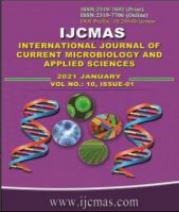


 National Academy of Agricultural Sciences (NAAS)
National Academy of Agricultural Sciences (NAAS)

|
PRINT ISSN : 2319-7692
Online ISSN : 2319-7706 Issues : 12 per year Publisher : Excellent Publishers Email : editorijcmas@gmail.com / submit@ijcmas.com Editor-in-chief: Dr.M.Prakash Index Copernicus ICV 2018: 95.39 NAAS RATING 2020: 5.38 |
Soil salinity kindles a cascade of events in the normal functioning of the plant. Plant experience changes in the morphological, physiological and biochemical aspects in response to salt stress. In the current study, several experiments pertaining to the changes due to salt stress has been studied in Mung bean. Morphologically, a significant decrease in fresh weight of roots (1.89 folds) was observed. About 3.27 and 3 fold decrease in the Relative Water Content and Chlorophyll levels, respectively were observed in 300mM NaCl treated and control mung bean plants. Proline level increased to 2.69 folds at 24 hrs in stress imposed plants compared to control. Molecular level changes due to salt stress was analyzed by Semi-RT-qPCR analysis. Total RNA was isolated from the control and salt-stressed samples and cDNA synthesized. Expression analysis of Late embryogenesis abundant(LEA) protein coding genes, VrLEA13 and VrLEA26 revealed amplicons of around 190 bp and 200 bp, respectively. This study creates an insight into the mechanism with which mung bean responds to salt stress by highlighting the significant variation in morpho, physio-biochemical and molecular responses.
 |
 |
 |
 |
 |